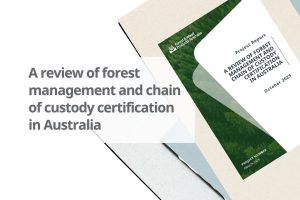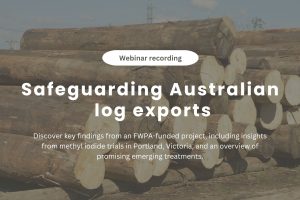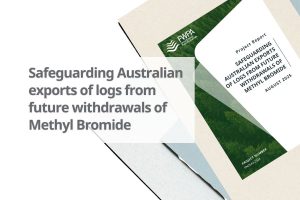As we are all keenly aware, the bushfire season of 2019/20 resulted in extensive loss and damage to Australia’s plantation and natural forest resources, as well as the destruction of many properties, the devastating impact on our wildlife, and the tragic loss of human life.
Everyone at FWPA was deeply saddened by the events that took place. We acknowledge the impacts of damaged assets on members and levy payers, and the significant effect this is likely to have on businesses for some years to come.
Throughout 2020, we have worked hard to reassure our community that we are with them on the journey towards recovery, and continue to take proactive steps to strengthen and support this process.
Our work in this area so far …
FWPA acted quickly in response to the situation, in a variety of ways. These ranged from developing educational materials and hosting public workshops to better prepare industry and the community for future bushfire events, to commissioning a leading fire engineer to develop a submission to an inquiry into the bushfires. The resultant report outlined recommendations for measures that can be taken to limit damage to properties during bushfire events.
As a priority, FWPA worked to support growers with information to help minimise the amount of damaged timber going to waste as a result of future fire events. Through a variety of research initiatives, a team headed up by the University of South Australia (UniSA) developed a set of guidelines for the future salvage, storage and processing of fire-damaged logs.
At the same time, as has been reported in previous editions of R&DWorks, UniSA established a diverse Technical Expert Working Group comprising around 25 members from all states. The team reviewed all available information, literature and reports pertaining to major fires in Australia’s past. This work resulted in the collation of historical information dating back as far as the 1920s, which was used to build an online knowledge base to support risk management and future planning. The report and spreadsheet are available by clicking here.
Later in the year, FWPA publicly called on researchers, foresters and professional firefighters to play their part in sharing their own intelligence around large-scale plantation losses, to help build the most comprehensive database possible.
“The collaborative contribution of time and expertise by the Technical Expert Working Group members is greatly appreciated,” said FWPA Research and Development Manager, Dr Chris Lafferty.
“We believe this is the first time a project on this topic has been undertaken with such a high level of national cooperation,” added UniSA General Manager of Forestry Research, Dr Jim O’Hehir.
Moving forward, the datasets will continue to grow, and be revised and improved over time, to ensure they remain as up-to-date as possible.
These examples were the tip of the iceberg in terms of the work FWPA has led or supported in response to the most recent, tragic bushfire season.
“We would like to reassure industry that we are thinking ahead, and remain committed to developing measures that will best support the sector through whatever lays ahead, and that our work in this area is still ongoing,” said Lafferty.
Characterising and managing fire risks to plantations under changing climates
One significant ongoing research project in particular is hoping to instigate a significant step forward in the capacity to understand and forecast fire risks to plantation and community assets.
“As we know, changing climates are creating significant fire risks to Australian plantations. Fires are predicted to become more frequent and intense, potentially resulting in increased plantation losses to bushfires,” said Dr Kate Parkins, Bushfire Risk Analyst, Ecosystem and Forest Sciences at The University of Melbourne, who is leading the project, which is being supported and managed by FWPA.
“Existing fuel accumulation models that feed into fire behaviour simulations do not adequately represent fire in some plantation types, so we wanted to make sure we looked at different species and different management practices, to ensure our predictions align with what is happening in the real world.”
By improving the approach to quantifying and predicting fire risk under changing climate conditions, and by providing evidence on the best ways to reduce those risks, this project aims to improve the likelihood of avoiding plantation fire losses in the coming decades, and thereby contribute to the resilience of the plantation industry and associated regional economies.
The project is therefore evaluating and quantifying fire risk in plantation regions across Australia, under current and changing climates, to support evidence-based assumptions around the ability of management to reduce fire damage and loss.
The research is national in scope and includes 10 plantation collaborators located from south-west Western Australia, to Tasmania and southern Queensland. Regional workshops are a vital part of the process, to ensure a localised approached that considers specific geographic conditions and management practices.
The team initially aims to develop improved fire-spread prediction models for plantations based on species, growth stage and management treatments. Beyond this, they will look to quantify current and future plantation fire risk over a 60 to 90-year period. This work will be complemented by the development of estimates regarding the extent to which preventative and responsive management practices can reduce fire risk and loss.
The industry will benefit from:
• region-specific case studies and models for predicting plantation fuel structure and fire behaviour
• fire risk profiles for plantations and nearby community assets under changing climates
• underlying data for evidence-based decision making around fire risks to plantations and community assets under changing climates.
This project was in the works prior to the catastrophic fire events of 2019/20. Dr Parkins explained these events didn’t have much of an impact on their approach.
“Our aims and objectives remained the same. What the most recent bushfire season did do, however, was demonstrate the importance and urgency of this work,” said Parkins.
“Part of what we’re trying to do is to identify the areas of highest future risk, and share our learnings with growers who can then work them into their planning. Being armed with this knowledge might encourage them to explore different plantation management practices, consider alternative locations for new plantations, or focus on early detection and suppression effectiveness.”
“So far we’ve enjoyed some really enthusiastic support from the growers we’re working with. They can all see the value in what we’re trying to do.”
The project has been running for six months and is due to conclude in August 2022.
Hi-tech camera to enhance Green Triangle fire management
In an Australian first, a robotic camera with the ability to undertake 360-degree scans of its surroundings is expected to enhance fire management practices across the Green Triangle this summer, improving the protection of assets and safeguarding the broader community.
The sophisticated FireHawk camera provides panoramic scans, and streams up-to-the minute surveillance, 24 hours per day. It has been installed at a communications tower near Tantanoola, South Australia, where the capability and effectiveness of its computer-aided fire detection and risk management system will be put to the test.
Early results have shown the camera can detect fires up to 30 kilometres away, providing the industry with confidence this technology has the potential to significantly enhance fire management during the coming season.
This initiative has been led by the Green Triangle Fire Alliance, which represents around 90 per cent of the region’s forest growers.
Using artificial intelligence and tailored algorithms, the system sends alerts to fire managers’ mobile phones when smoke is first identified, allowing for an immediate response. The same technology is already being used in countries including Chile and South Africa, with great success.
Chair of the Green Triangle Fire Alliance, Laurie Hein said the local trial, funded by industry members themselves, has highlighted the potential for a camera system to further support existing fire detection systems.
“This technology is one of the more advanced detection tools we have seen in fire management in the Green Triangle since the introduction of digital communication tools,” Hein said.
“We know early detection is critical in managing and suppressing wildfire, and this system has the capability of providing a far greater level of defence than we have ever experienced before.”
Chair of the Green Triangle Forest Industries, Ian McDonnell said the trial was another key example of the ways the forest and wood products sector is introducing world-best technologies to protect the supply chain from bushfire events.
Please do not hesitate to reach out to FWPA directly if we can provide assistance, or you have suggestions for how else we can support you.



